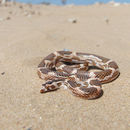en
names in breadcrumbs


Nocturnal with some fossorial tendency. Although this snake has special adaptations to life in sand, it is widespread even in very rocky regions, such as wadis of the Eastern Desert and South Sinai. The species seems capable of exploiting the smallest sand patches, from where it wanders onto harder substrates.
Least Concern
A small, slender snake. Largest Egyptian specimen has a total length of 435 mm. Tail relatively short, tail / total length = 0.16-0.19. Rostral shield wedge-like, broadly truncate, protruding well beyond the lip; 7-8 supralabials, fourth or fifth or both enter the eye, 152-177 ventrals, 33-49 paired subcaudals, 19 scale rows around mid-body; anal divided. Dorsum sandy, with a pattern of ovoid brown blotches interspersed with light transverse dashes; a dark interorbital bar usually connected to a longitudinal band that extends on to neck. Venter uniformly white.
Widely distributed throughout almost all parts of Egypt, with the exception of the agricultural lands of the Nile Valley and Delta. Most widespread in the dunes of North Sinai, the northern Eastern Desert, oasis of the Western Desert and the western Mediterranean coastal plain. Exceptional records include two animals found under a large rock in the upper reaches of Wadi El Allaqi, and fresh tracks in Karkur Talh, Gebel Uweinat.
North Africa from Morocco to Israel and Palestine, south to the Sahel.
Sandy biotopes in a wide variety of desert habitats, but most common in moderately vegetated dunes.It has been found from near sea level to about 1,500 m in the St. Katherine area.
Fairly common and widespread. Collected in large numbers for the pet trade. Rather easy to detect in sandy habitats by its distinctive tracks.
Lytorhynchus diadema, the crowned leafnose snake, diademed sand snake, or awl-headed snake, is a non-venomous snake[2] found in Middle East, North Africa & West Asia.
Lytorhynchus diadema adults range from 30-51 cm in length.
Pale buff or cream color above, with a series of 13 – 18 large transversely rhomboidal dark spots; a dark median band along the head and nape, sometimes confluent with an interocular transverse band; an oblique dark band from the eye to the angle of the mouth; lower parts uniform white.[3]
Algeria, Egypt, Iran, Iraq, Israel, Jordan, Kuwait, Libya, Morocco, Niger, Oman, Saudi Arabia, Tunisia, United Arab Emirates, Yemen, Mauritania, West Sahara.[2]
This species is found in sandy desert, semi-desert, sandy coastal areas, areas of high grassland plateaus (especially those close to rocky areas), and clay plateaus with rocks. This species digs, but is not considered fossorial In Arabia it appears to occur in a wide range of dry habitats.[4]
It feeds mainly on lizards but will eat large arthropods, insects and young rodents.
The species is oviparous, laying clutches of three to five eggs.
Lytorhynchus diadema, the crowned leafnose snake, diademed sand snake, or awl-headed snake, is a non-venomous snake found in Middle East, North Africa & West Asia.